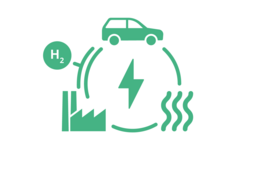Sector coupling and hydrogen

Sector coupling is a fundamental element of the holistic energy transition. It primarily entails creating connections between the production of renewable energies on the one hand and the consumption of this energy in the industrial, mobility and building-heating sectors on the other. In order to advance the energy transition in a productive and consistent manner, it is important to align the technical facilities, infrastructures and markets in the different sectors more closely – both across and within sectors – in order to establish a comprehensive and intelligent energy system. This presents the overall energy supply system with new challenges. A particular requirement is the flexibility of the system – that is, the ability to respond to fluctuations in production. An important building block in this respect is power-to-gas technologies. Through the conversion of electrical energy to hydrogen via so-called electrolysis, energy can be stored for the mid to long term and used in a variety of ways. Where required, the energy can be converted back into fuel cells and hydrogen-capable power plants – ideally while also utilising the lost heat. Alternatively, the energy can be used as fuel in fuel cell vehicles in areas where electric-battery-powered vehicles are not suitable for use. Hydrogen and hydrogen derivatives can also be used as fuel in industry to replace fossil fuels.
In its research, the CC4E focuses on green hydrogen. The energy required for the electrolysis used to produce it is obtained from renewable energies. An additional area of research is the production of turquoise hydrogen. It is generated by splitting methane into hydrogen and elemental carbon. The powdered, pure carbon – also called carbon black – is therefore a bound solid and can be integrated into industrial processes where required. The research aims to identify ways to generate CO2-neutral or even CO2-negative hydrogen. Additionally, the CC4E operates a plant which captures and utilises CO2 from the surrounding air (CO2 direct air capture).
For the concrete testing of the various technologies in the area of sector coupling, the CC4E uses the technical research infrastructure at the Energy Campus Technology Centre, which is operated as a 'grid-interactive efficient building'. Work is also carried out at our project partners' facilities, which are made available for research purposes.
Our central research topics are grid interactivity, grid integration, storage and charging management: The demand-side integration research area deals especially with the grid-interactive use of electricity produced with renewable energies. Both energy producers and various flexible energy users are involved in the work at the Energy Campus Technology Centre for this purpose. In the area of energy storage, we are developing and testing diverse storage concepts with the help of battery, hydrogen, methane, and heat and cold storage systems. To investigate system integration solutions for renewable energies, a battery storage system was also operated at the Curslack Research Wind Farm as part of a research project.* We are also studying how energy efficiency can be optimised with the help of intelligent and variable control and regulating concepts. This also includes intelligent charging management, which increases the share of locally produced renewable energies and maximises charging performance. Software solutions, in turn, support grid-interactive charging operations.
* Because the research project has now been completed, the battery storage system provided by the project partner has been dismantled. The infrastructure and subcomponents remain on site and follow-up projects are planned.
Sector coupling and hydrogen – Team contact information
Prof. Dr. -Ing Hans Schäfers
T+49.40.428 75-5895
Martin Grasenack
T+49.40.428 75-5801
